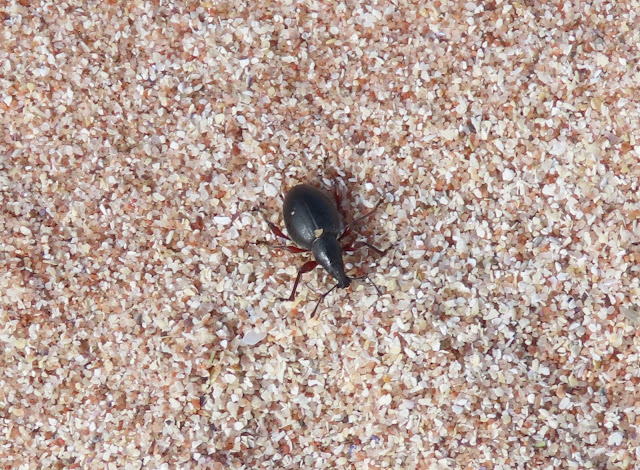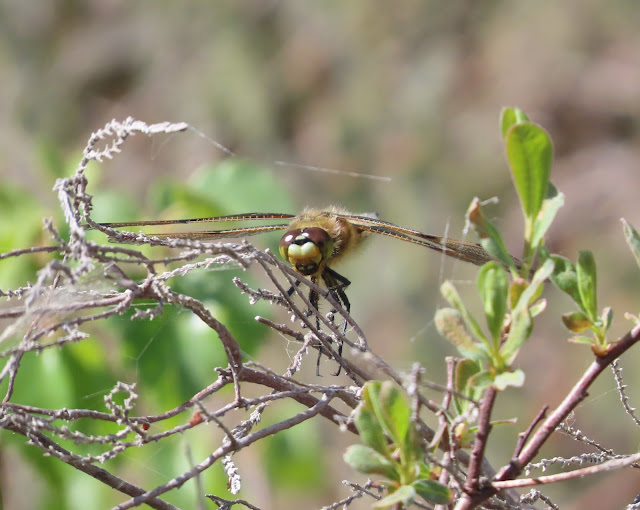Friday, May 30, 2025
"If you get into the world of weevils, you're going to be confused for a hundred years" - Greger's somewhat distracted comment when I complained that on-line info concerning this tiny creature wasn't straightforward.
But what were those strange feathery things towering over a second patch of the flowers (or at least their distinctive leaves)? Looking it up at home I learnt that they are the mountain avens after flowering - the silky twists later opening out to carry the seeds off on the wind. Amazing. I'm so glad I saw them.
Thursday, May 22, 2025
Thursday, May 15, 2025
A warm dusty walk up the quarry road as far as the river brought sightings of narrow-bordered bee hawk-moths - a single one at the top of the road and two at the bottom, near the lower quarry (or sorting yard).
Monday, May 12, 2025
Beinn Liath Mhor a' Ghiubhais Li
We set our alarms for 6.30 this morning, but by the time we had driven up the Dirrie More, the car park for the Fannichs was already full; everyone, it seemed, wanted to get an early start on what promised to be a very warm day as there's nowhere to find shade in these hills. Greger parked on the verge by the bridge, which is better as it means a shorter walk on the road.
Going up through the plantation we heard cuckoo, willow warblers, and a chaffinch; and on the slopes above the end of the track there were meadow pipits. It was difficult to look ahead as we were walking into the sun, but soon a wheatear presented a silhouetted profile on the skyline. We both then spotted a nearby ptarmigan.
The ptarmigan remained in the same place as we walked carefully upwards - and then stretched up and started to run across the hillside, finally taking to the air with a croak and landing off to our right, where he strutted about with his tail cocked. Then there two of them, flying across the slope below us, one seemingly chasing the other. When one of them flew back again, I managed a poor flight shot.
I'm pretty sure these were two male birds, disputing territory.
Greger reaches the first cairn.....
.....from which it's a short walk across the stony, mossy plateau to the main summit. In the shelter, there is a curious brass-like knob, firmly set into the rock.
Some walkers' online reports talk of a "destroyed" trig point or the "remains of a trig point"; but Greger was sceptical about this. So we researched it and found that it's an OSBM bolt (probably brass); these were set into rock or masonry and served as a survey marker, when a full trig pillar wasn't needed. (This info is from AI Overview, after which you are warned "AI responses may include mistakes"!)
Several bumblebees seemed to be buzzing around as we ate lunch, and I managed to catch up with one. I'd thought at first it could be an early bumblebee; but it didn't look quite right, and back at home I finally identified it as a bilberry bumblebee (Bombus monticola).
There was a wheatear on the northern flank just below the summit; I'm not sure how I managed to take such awful pictures of it, but I'll blame distance, foreground rocks, and the heat haze!
We lingered for a while on the summit as it was so nice (albeit with a coolish wind from the north-east) and as we wandered over to the southern side, I spotted red deer in a lochan far below. I've only seen this once before, and that was during a very hot hill-walk near Glencoe back in 2006. As I clicked off some pics, I thought: At least I'll get better ones this time, as I have a better camera. Huh!
Oh well. Interestingly, a few years after my sighting, there was a Country Diary in the Guardian written by Ray Collier (1937-2017), who reported red deer standing in a river on a very hot day and remarked that he'd never seen that before - walking and swimming yes, but not just standing still for any length of time. We noted that a few small patches of snow remained high on three surrounding mountains and then set off down.
Before we left the interesting zone I wandered to and fro across the hillside, searching for trailing azalea and not sure it would be in flower yet. But at last I spotted some - with plenty of beautiful pink buds and also some flowers!
As I snapped this lovely montane plant I became aware of a fly or hoverfly on the top of the rock. Instead of flying off, it walked towards me, its eyes seemingly fixed on me in a slightly unnerving way.
I don't know what it is, but it could be a botfly - and the idea that it had mistaken me for a deer and was sizing me up as a potential host for its larvae was enough to make me put my camera away and hurry off downhill after Greger.
Near the bottom of the plantation track, my attention was caught by my first dragonfly of the year landing nearby - I think it was a four-spotted chaser. It flew, and was replaced by a green hairstreak butterfly.
Length of walk: 9 km. Height of hill: 766m (2513ft): Elevation: 506m as starting point at 260m. My 11th ascent of this hill and Greger's 9th - and quite possibly our last!
Sunday, May 11, 2025
I've been researching the drake at the mouth of the Ullapool River (previous post) and I see no reason why it shouldn't be a "proper" gadwall. They seem to be recorded fairly frequently over east and on the Western Isles. I initially had doubts about the bill - it looked a bit messy in its colouring and slightly on the large side (I recall male gadwalls down south as dapper grey ducks with neat black bills); however, the bodywork seems perfectly okay for gadwall, so I'll tick it for the year - and for Scotland.
Saturday, May 03, 2025
I searched the harbour and the spit for yesterday's white wingers, wanting to confirm ID - but there was no sign of them. I was surprised to see what appears to be a gadwall off the river spit.....
Friday, May 02, 2025
Having spent the windy, showery morning doing domestic jobs, I decided after lunch on a quick drive up to Keanchulish, where I sat in the car for about twenty minutes listening out for a grasshopper warbler. Nothing happened, so I drove back to the village, and parked on West Terrace. There were loads of gulls down on the golf-course spit - surely there would be something good there? A scan through the bins quickly produced a white winger - amazing how well they stand out, even at a distance.


.jpeg)






















